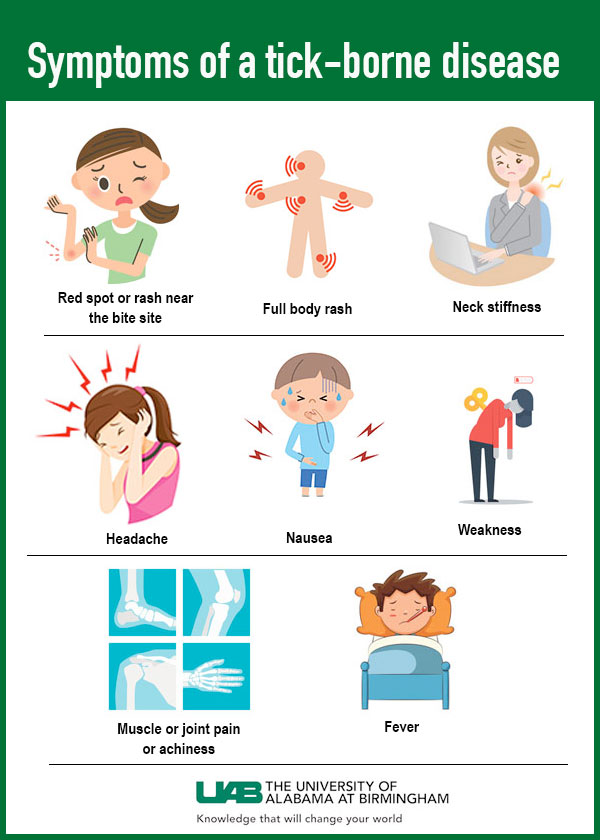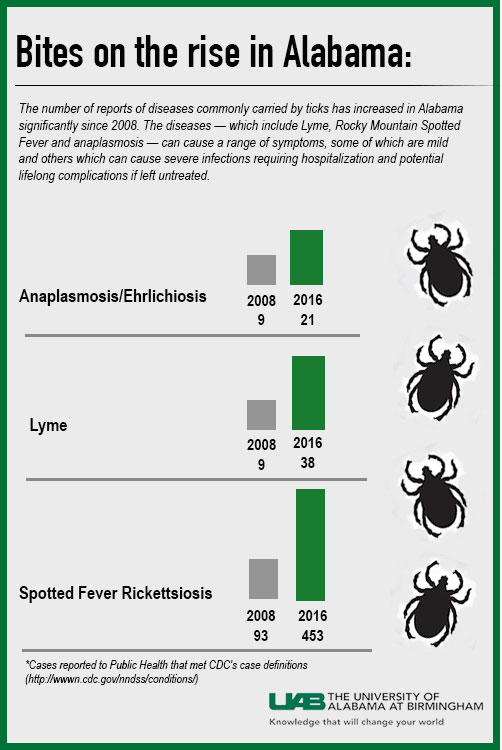The tick is a hideously ugly pest that begets exactly what you might expect from such a blood-sucking creature — a variation of 14 different nasty, infectious diseases. The good news is tick-borne diseases are usually easily treatable. The bad news is that they can often be difficult to diagnose.
 Tick bites and the diseases the pest causes have been in the headlines recently, and for good reason. The number of tick-borne diseases reported each year is increasing, including in Alabama.
Tick bites and the diseases the pest causes have been in the headlines recently, and for good reason. The number of tick-borne diseases reported each year is increasing, including in Alabama.
The Alabama Department of Public Health reports that the number of Lyme disease cases reported has risen from two in 2010 to 38 in 2016. Reported cases of the disease anaplasmosis, also transmitted to humans by the bite of an infected tick, have averaged almost 20 cases a year for the past five years. And the most common disease on the rise from tick bites in Alabama — Rocky Mountain Spotted Fever, or Spotted Fever Rickettsiosis — has jumped from 79 cases in 2011 to 453 in 2016.
Walter Schrading, M.D., director of the University of Alabama at Birmingham’s Office of Wilderness Medicine, says UAB Hospital has had only one case of Lyme disease diagnosed so far in 2017, but says he expects to see more as the year goes on.
“True tick-borne disease is fairly rare,” Schrading said, “but we do expect to have a lot more instances of tick-borne disease due to the warm, dry winter.”
Lyme disease is the most commonly reported vector-borne illness in the United States, according to the ADPH, and is spread by the brown deer tick, a very small tick that is much smaller than the more common dog tick; it’s about the size of the tip of a pencil.
The process in which the tick delivers its pathogens is not for the faint of heart.
Once a tick finds a host, it uses its incisor-like claws to tunnel beneath the skin, often in seconds, latches on with two legs and cuts open the skin with a mouth that resembles a reciprocating saw. After it injects its long, jagged mouth, it becomes difficult to remove from the skin. It then begins to draw blood up slowly before it reverses the flow and squirts saliva into the wound.
This brings with it increased risk for Lyme disease, Rocky Mountain Spotted Fever, ehrlichiosis and tularemia — all of which can range from mild symptoms treatable at home to severe infections requiring hospitalization and potential lifelong complications. Lyme disease, Rocky Mountain Spotted Fever, tularemia and anaplasmosis are the tick-borne illnesses seen most frequently in Alabama and other Southern states.
“It is important to realize that, for the tick to actually transmit disease, it typically needs to be attached for about 24 hours or become engorged,” said Schrading, who is also an associate professor in UAB’s School of Medicine. “If a tick is crawling on the skin or is quickly removed, the chance of transmission of any infectious disease is extremely unlikely. However, after removing an engorged tick, one should be aware of flu-like symptoms, fever or rash in the following two to three weeks and seek treatment if this develops.”
Most tick-borne diseases can be treated early effectively with antibiotics, although rare long-term complications of Lyme disease include arthritis, cardiac and neurologic symptoms. “Often, these diseases are easily treatable with antibiotics, but the problem is that they are diseases that can be difficult for physicians to diagnose,” Schrading said.
Potential symptoms of a tick-borne disease include:
- A red spot or rash near the bite site, often in the form of a bull’s-eye
- A full body rash
- Neck stiffness
- Headache
- Nausea
- Weakness
- Muscle or joint pain or achiness
- Fever
Powassan and the Lone Star Tick
Two new high-profile tick-borne diseases — Powassan virus and Southern Tick Associated Rash Illness — have not been reported in Alabama thus far.
 Powassan virus is rarer and more deadly than the bacteria that causes Lyme. The Centers for Disease Control has 75 recorded cases of Powassan virus from 2006-2015. Powassan attacks the nervous system and can infect the brain, causing encephalitis. It can also infect the lining of the brain, causing meningitis. Approximately 10 percent of people who develop brain swelling and meningitis die, and almost half of those who survive have permanent neurological damage, which includes blurred vision, facial tics and memory problems.
Powassan virus is rarer and more deadly than the bacteria that causes Lyme. The Centers for Disease Control has 75 recorded cases of Powassan virus from 2006-2015. Powassan attacks the nervous system and can infect the brain, causing encephalitis. It can also infect the lining of the brain, causing meningitis. Approximately 10 percent of people who develop brain swelling and meningitis die, and almost half of those who survive have permanent neurological damage, which includes blurred vision, facial tics and memory problems.
Some scientists fear that Powassan could spread rapidly now that the disease has been confirmed to be spread by the deer tick. To this point, Powassan has been most common in the upper Midwest and New England.
The STARI disease has quickly gained notoriety nationally because, when transmitted by the Lone Star Tick, it has made humans allergic to just a single bite of meat.
The tick, which gets its name from the Texas-shaped splatter of white on its back, can reprogram the human immune system to forever reject red meat, pork, chicken and other meats. The Lone Star Tick does not transmit Lyme disease, according to the CDC. The tick has been found throughout the southeastern and south-central states and has recently been found as far north as Minnesota, New Hampshire and the eastern tip of Long Island.
How to remove a tick and prevent bites
Schrading says, if you find a tick on yourself or a loved one, there is no need to panic. “Removing the tick can be accomplished quite effectively and quickly with a set of fine-tipped tweezers,” he said.
The CDC recommends taking the following steps to remove a tick:
- Use fine-tipped tweezers to grasp the tick as close to the skin’s surface as possible.
- Pull upward with steady, even pressure. Don’t twist or jerk the tick; this can cause the mouth-parts to break off and remain in the skin. If this happens, remove the mouth-parts with tweezers. If you are unable to remove the mouth easily with clean tweezers, leave it alone and let the skin heal.
- After removing the tick, thoroughly clean the bite area and your hands with rubbing alcohol, an iodine scrub, or soap and water.
- Dispose of a live tick by submersing it in alcohol, placing it in a sealed bag/container, wrapping it tightly in tape, or flushing it down the toilet.
Schrading says never crush a tick with fingers, and avoid folklore remedies like using nail polish, heat or petroleum jelly to encourage the tick to detach from the skin. “It’s best to remove the tick as quickly as possible,” he said.
As for avoiding tick bites, Schrading says the best methods to employ are using insect repellents containing DEET or permethrin and wearing long pants and socks if tick habitats including the woods and brushy areas cannot be avoided.
“After hiking or walking through the woods or thick brushy areas, always perform tick checks,” Schrading said. “Look in and around the hair and ears, under the arms, inside the belly button, the backs of the knees, between the legs, and around the waist.”